|
1.
CENTRAL AND WEST AFRICA
Asian buyers more active
Reports suggest that across the region there has been a
resurgence in enquiries from Asian buyers signalling the
possibility that trading will become more active. Optimism
has grown as importers in China have expanded interest in
a variety of species including bilinga, ayous, okan,
movingui, belli and sapelli alongside the traditionally
sought after,okoume.
The renewed and steady demand from the Philippines has
contributed to the overall positive sentiment among
producers in the region. In contrast, demand in Middle
Eastern markets remain relatively subdued.
Enquiry levels across Europe remain stable, say producers.
Specific attention in EU markets is directed towards
andoung, iroko and padouk species.
Prices have remained stable as there is adequate
production in Gabon, Cameroon and the Republic of
Congo effectively balancing demand and supply.
A shift in market dynamics has been reported as the export
of Azobe logs has declined considerably which has been
attributed to the closure of sawmills in Europe and a pivot
towards importing sawnwood .
Stringent sustainability practices demanded in Gabon
As things stand at present in 2025 all forestry operations
in Gabon will have to secure FSC certification, a move
towards more stringent sustainability practices. This
legislative push has been reinforced by the Forestry law
mandating full payment of land taxes. The firm stance
taken by the government underscores the commitment to
enforcing environmental standards.
Expat visa issue looms large
Activities under the ongoing National Transition and
Restoration Convention (CTRI) are being managed
through sub-commissions including Labour, Economics
and Finance. The Economic sub-commission is addressing
the critical issue of unemployment among Gabonese
nationals along with the need for expatriate professionals.
In the labour sub-convention was a proposal which
involves controls on expatriate workers through a new
system of work permits and subsequent residency permits
to do away with the issuance of E-Visas for employment
purposes as such visas are intended for visitors and are
limited to a three-month stay.
The new government wants to prioritise local employment
and seeks to regularise the involvement of expatriate
workers. It has been said too many expatriates have been
working under E-Visa arrangements, a legal grey area with
inadequate oversight.
The changes being considered suggest a pivot towards a
more regulated and domestically focused labour market
and this will have implications for the timber sector and if
not managed well could undermine production levels.
Cameroon – shipment dates pushed forward as
demand grows
The dry season, lasting until June, has allowed operators to
replenish log stocks and a resumption of full scale milling.
Operators in Cameroon report an improvement in
transportation operations, both trucking to mills and log
depots as well as railway operations for export shipments.
Douala Port operations are reported as running smoothly
and some have reported improvements under the new
management. Kribi Port is also operating effectively,
mainly handling container traffic.
Producers in Cameroon report stable enquiry levels and
that delivery dates have to be extended due to the uptick in
demand in Asian markets. It is understood that the log
export ban is now being fully imposed with no exceptions
and only processed products may be exported.
Order levels stable in Congo
Harvesting conditions in Northern Congo continue to be
challenging due to heavy rains which has complicated
transportation to Douala Port. On the positive side
producers in Congo report resumed interest in okoume
since the beginning of April.
Overall, producers report that order levels have been stable
for two months. Log exports are banned except for stocks
of old stocks. Enquiry levels are also stable, with the
Philippines returning as a buyer of okoume sawnwood and
Chinese interests expanding to a wider range of species.

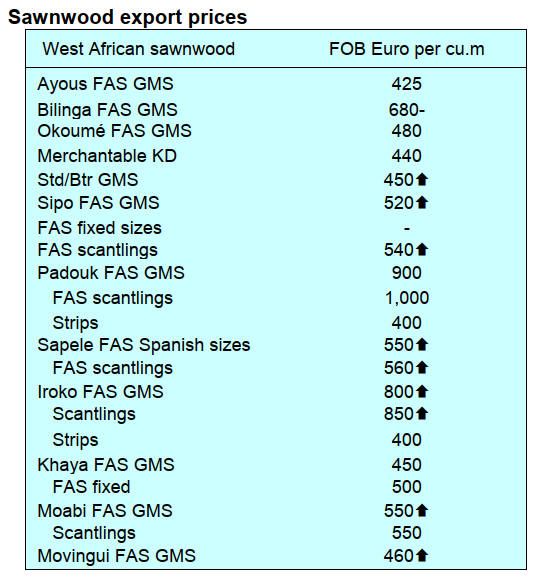
Through the eyes of industry
The latest GTI report lists the challenges identified by the private
sector in the Republic of Congo and Gabon.
GGSC
https://www.itto-ggsc.org/static/upload/file/20240418/1713424567120852.pdf
2.
GHANA
Ghana’s billet exports surged in first two
months of
2024
Ghana exported a total of 40,763 cu.m of wood products
in the first two months of 2024 compared to 44,400 cu.m
recorded for the same period in 2023, a drop of 8%
according to Timber Industry Timber Division (TIDD).
The corresponding export value for the same period
dropped from Eur19.84 million in 2023 to Eur18.49
million in 2024.
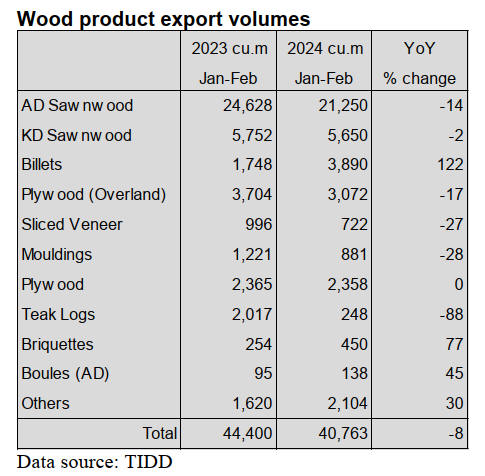
Of the fifteen products exported the top five were air-dried
sawnwood (21,250 cu.m, 52%), kiln-dried sawnwood
(5,650 cu.m, 14%), billets (3,890 cu.m, 9.5%), plywood to
the regional market (3,072 cu.m, 7.5%) and plywood for
overseas export (2,358 cu.m, 6%). These altogether
accounted for 89% of the total export volume (40,763
cu.m).
Billets recorded a significant y-o-y growth in export
volumes during the first two months of this year, from
1,748 cu.m in 2023 to 3,890 cu.m in 2024. This was
closely followed by rising exports of air-dried boules and
briquettes while all others products recorded lower export
volumes in the first two months of 2024 compared to
2023.
Billets are a primary product produced mainly from teak
and gmelina and are shipped primarily to India.

The major markets for wood products from Ghana in the
first two months of this year were Asia (60%), Europe
(17%), Africa (11%), America (7%) and Middle East
(5%).
Chamber of Commerce – power outages bringing
businesses to their knees
The Ghana National Chamber of Commerce and Industry
(GNCCI) has voiced deep frustration and disappointment
at the ongoing power crisis in the country.
According to the Chamber, the frequent power outages,
(dumsor) have brought some businesses to their knees
causing significant declines in productivity and revenue
and occasional damage to machinery.
The GNCCI said the current power crises, coupled with
the country’s current economic challenges such as the
depreciation of the cedi against major foreign currencies,
high-interest rate, escalating cost of fuel, high inflation
among others, put businesses in an extremely risky
situation. The GNCCI has pleaded for immediate action by
the government and all stakeholders on the power crisis.
A recent statement from the Ghana Grid Company
Limited (GRIDCo) has said it anticipates securing about
100 megawatts from the Independent Power Producers
(IPPs) in the coming days to reduce power outages.
Source:
https://www.myjoyonline.com/dmusor-has-brought-businesses-to-their-knees-gncci-expresses-frustration-at-ongoing-crisis/
and
https://www.myjoyonline.com/gridco-to-receive-100mw-power-supply-from-ipps-in-coming-days/
Ghana’s secures MoU on debt restructuring
The domestic media has reported Ghana secured a
Memorandum of Understanding (MoU) from its creditors
on restructuring Ghana’s commitments. This came after
members of the official creditor committee and Ghana’s
bilateral creditors managed to secure the necessary
approvals.
In its April 2024 Fiscal Monitor the International
Monetary Fund (IMF) forecasts a consistent decline in
Ghana’s Debt-to-GDP ratio in the next six years.
According to Stephane Roudet Fund Mission Chief for
Ghana, the government policies and reforms to restore
macroeconomic stability and debt sustainability are laying
the foundations for stronger and more inclusive growth
and are already generating positive results.
In a related development, Fitch Solutions has stated that
the Ghana cedi will soon appreciate citing several factors,
notably the progress the government has made regarding
the restructuring of its commercial debt. This will bolster
investor confidence in Ghana’s economy and
policymaking processes leading to increased foreign
exchange inflows and a consequent strengthening of the
cedi possibly in the second half of 2024.
See:
https://www.myjoyonline.com/ghana-reaches-a-deal-with-bilateral-creditors-on-debt-restructuring/
and
https://dailyguidenetwork.com/fitch-solutions-predicts-ghanaian-cedi-to-bounce-back/
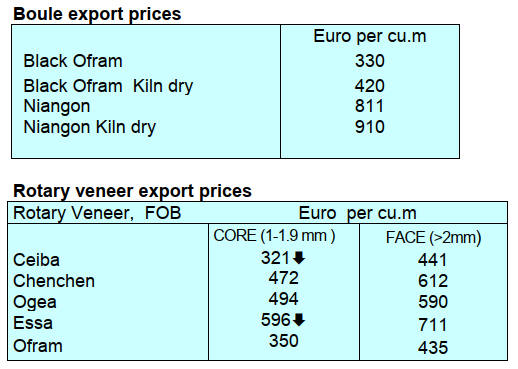
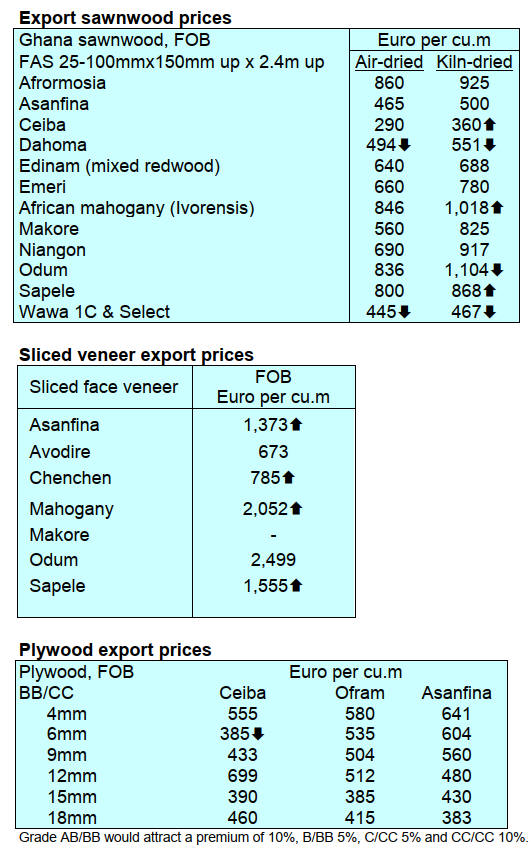
3. MALAYSIA
Export earnings rise
Despite a marginal contraction of 0.8% in March export
earnings to RM128.64 bi.l there was an overall increase in
first quarter earnings. The Ministry of Investment, Trade
and Industry said total exports grew 2.2% during the first
three months of 2024 to RM362.41 bil. on the back of
higher shipments of manufactured and mined goods.
On imports, the value of Malaysia's inbound shipments
expanded at a rate of 12.5% y-o-y to RM115.83 bil. in the
first quarter.
Automation and digitalisation the way forward
The Malaysian timber industry is being urged to adopt
automation and digitalisation to tackle increasingly
complex global challenges. To assist with this
transformation the Malaysian Wood Moulding and Joinery
Council (MWMJC), in collaboration with the Malaysian
Timber Industry Board (MTIB), has organised
programmes and initiatives aimed at strengthening the
competitiveness of the sector.
In addition to supporting its members the MWMJC also
provides feedback on government policies and promotes
sustainability within the sector. Its chairman, George Yap,
acknowledged the multifaceted challenges confronting the
industry including raw materials scarcity, demands for
timber certification and the imperative of adhering to
environmental, social and governance principles.
Exports of wood products fell by 13% to RM 21.9 billion
in 2023 compared with RM25.21 billion in 2022. The
major wood products exported from Malaysia last year
were wooden furniture, plywood, sawnwoodr, builders'
joinery, mouldings and fibreboard. Among the top export
destinations were the United States, Japan and India.
MWMJC members primarily focus on downstream
production and supply the international and domestic
markets. The finished products include mouldings, doors,
windows, flooring, decking, skirting, picture frames,
furniture and wooden structures for building and marine
applications.
See:
https://www.nst.com.my/news/nation/2024/03/1031880/automation-digitalisation-boost-timber-industry
Sabah rainforest project generates first carbon credits
The Kuamut Rainforest Conservation Project (KRCP) has
achieved a milestone by generating its first tranche of
verified carbon units. The project is a public-private
partnership between the Sabah Forestry Department,
Yayasan Sabah and United Kingdom-based Permian
Global's local subsidiary, Permian Malaysia.
Permian Global chairman, Stephen Rumsey, said the
verification demonstrated the project's compliance with
internationally recognised standards. This achievement
enables the conservation initiative, aimed at protecting and
restoring 83,000 hectares of tropical rainforest in the
Tongod and Kinabatangan districts, to generate its first
saleable carbon units.
Permian Global had provided investment for the project
that involved State authorities along with scientific and
community partners such as the South East Asia
Rainforest Research Partnership (SEARRP) and the
community organisation PACOS Trust.
See:
https://www.nst.com.my/news/nation/2024/04/1038666/sabah-rainforest-project-generates-first-tranche-carbon-credits
Longest running tropical forest certification
The Deramakot Forest Reserve in Sabah has received its
fifth cycle of forest certification under the Forest
Stewardship Council (FSC) certification; the first cycle
began in 1997. This re-certification extends to another five
years, from March 2024 to March 2029 making
Deramakot Forest Reserve the longest running FSC-
certified tropical forest in the world.
Frederick Kugan, the Chief Conservator of Forests in
Sabah praised the efforts and hard work shown by all
officers involved in maintaining the world standard of
forest management in Deramakot which is an outstanding
achievement not only for Sabah and Malaysia but also for
all the tropical forests in the world. As of March 2024 the
SFM system, as practiced in the Deramakot area, has
multiplied to 43 Sustainable Forest Management License
Agreements (SFMLAs) covering some 1.53 million
hectares.
However, Sabah still faces challenges in obtaining FSC
and MTCS-PEFC certification for forest plantations.
These can only be granted for forest plantations
established before 2020 for FSC and before 2010 for
MTCS-PEFC along with some other restrictions.
Exhibitors already securing slots for MIFF 2025
The 30th Malaysian International Furniture Fair concluded
on a high note say the organiasers as exhibitors and buyers
forged connections and capitalised on robust business
opportunities. The event attracted 715 exhibitors and
19,213 trade visitors from 120 countries and regions. The
organisers say the positive response received throughout
the show has resulted in over 80% of exhibitors already
securing their space for the next show. The annual event
will run 1-4 March 2025.
See:
https://www.malaymail.com/news/malaysia/2024/03/28/deramakot-forest-reserve-in-sabah-is-longest-fsc-certified-tropical-forest-in-the-world/126013
Through the eyes of industry
The latest GTI report lists the challenges identified by the private
sector in Malaysia.
GGSC
https://www.itto-ggsc.org/static/upload/file/20240418/1713424567120852.pdf
4.
INDONESIA
Anticipating impact of global
geopolitical situations on
industry
The Ministry of Industry is closely monitoring the volatile
global geopolitical situation as it is anticipated current
conflicts will have an impact on at least three things:
energy prices, logistics costs and exchange rates. The
government intends to continue developing policies to
mitigate any impact on the local manufacturing industry.
The Minister of Industry, Agus Gumiwang Kartasasmita,
has indicated the Ministry is considering incentives for
imported industrial raw materials due to the possibility of
disruption of the supply of raw materials for domestic
industry. A relaxation of imports curbs is also being
considered to make it easier to secure raw materials.
In an effort to reduce the dependence on the US dollar the
Ministry has called for an increase in the use of the Rupiah
for bilateral transactions between Indonesian businesses
and their partners in other countries.
In addition, the Ministry has called for efforts to improve
performance in the logistics sector to support the growth
of the industrial sector. The Minister noted that during the
first quarter of 2024 the world logistics cost index
increased due to the varous global conflicts.
See:
https://www.kemenperin.go.id/artikel/24656/Kemenperin-Siapkan-Antisipasi-Dampak-Situasi-Geopolitik-Dunia-Bagi-Sektor-Industri
Gen-Z and millennials to play a key role in
forest
management
Agus Justianto, Acting Director General of Sustainable
Forest Management at the Ministry of Environment and
Forestry (KLHK), has reiterated that forest businesses in
the future will not only rely on timber harvesting but will
adopt a multi-business approach. He said to achieve this
the younger generation, which includes individuals from
the Gen-Z and Millennial age groups, can bring creativity,
innovative ideas and technological skills that can be
utilised to support the multi-business approach.
He added "it is hoped that the younger generation of the
Gen-Z and Millennial groups who are creative, innovative
and able to leverage technological advancements can
become the key players in implementing Multi Forestry
Busines.,
He emphasised the importance of sustainable management
of forests, which besides having a foundation in
economics, also has ecological, hydrological and
climatological functions.
See:
https://www.antaranews.com/berita/4057881/klhk-gen-z-dan-milenial-pilar-penentu-pengelolaan-hutan-lestari
and
https://www.medcom.id/ekonomi/bisnis/zNPXaWPN-gen-z-dan-milenial-bekal-utama-pengelolaan-hutan-lestari
APP Joins the World Business Council for Sustainable
Development
A media statement from the World Business Council for
Sustainable Development says “the APP Group has joined
more than 200 leading global companies as the newest
World Business Council for Sustainable Development
(WBCSD) member.
APP Group oversees multiple pulp and paper
manufacturing and forestry enterprises in Indonesia to
meet the growing global demand for tissue, packaging and
paper products in over 150 countries.
By joining forces with other industry leaders within
WBCSD, APP is set to further enhance its sustainable
development efforts and integrate these principles into its
business operations, align with WBCSD’s mission to
accelerate the required transformation of businesses, their
value chains, and the systems in which they operate, to
limit the impact of the climate crisis, restore nature and
tackle inequality.
APP has implemented a comprehensive sustainability
approach and is committed to transparent ESG disclosures.
Its ERM aligns with key ESG risks. APP’s participation as
a WBCSD member also aims to advance progress toward
achieving its ambitious sustainability goals - including net-
zero emissions by 2050, setting targets for forest
conservation, upholding human rights, promoting
inclusion and diversity, and maintaining transparency in
accordance with the International Financial Reporting
Standards (IFRS)”.
Andrie Setiawan Yapsir, Director of APP Group said
“joining the WBCSD is a crucial step for APP Group in
reinforcing our dedication to environmental and social
responsibility and assuring our stakeholders of our
commitment to not only meet but exceed global standards.
This collaboration aligns with our goals, set out in
our Sustainability Roadmap Vision 2030 and enables us to
further enhance our capacity to implement effective
solutions for a sustainable future”.
See:
https://www.wbcsd.org/Overview/News-Insights/General/News/APP-Joins-the-World-Business-Council-for-Sustainable-Development
Be ready for carbon trading by October 2024
Presidential Chief of Staff, Moeldoko, has emphasised that
President Wiodo wants to see carbon trading in Indonesia
running smoothly before the end of his term as President.
Moeldoko stressed the need to speed up preparation and
alignment of regulations, particularly in sectors that fall
under the Nationally Determined Contribution (NDC).
This includes areas such as energy, waste management,
industrial processes, the utilisation of agricultural
products, forestry and other sectors that are affected by
advancements in science and technology such as blue
carbon.
In response the Director General of Climate Change and
Control at the Ministry of Environment and Forestry
(KLHK), Laksmi Dewanti, explained that in preparing the
regulations the Ministry will ensure that measures set
forcarbon trading can contribute to reducing emissions
following the NDC targets in the Paris Agreement.
See:
https://tirto.id/ksp-perdagangan-karbon-harus-berjalan-optimal-sebelum-oktober-gXYV
and
https://koran-jakarta.com/ksp-tegaskan-penerapan-perdagangan-karbon-harus-optimal-sebelum-oktober-2024
Finance ministers' role in achieving NDC targets
Finance Minister, Sri Mulyani Indrawati, highlighted the
role of finance ministers in ensuring their countries
achieve Nationally Determined Contribution (NDC)
targets to address climate change.
These remarks were made when the Minister presided
over the 11th Ministerial Meeting of the Coalition of
Finance Ministers for Climate Action (CFMCA).
Apart from assuring financial support, Indrawati
emphasised the need for Finance Ministers to take part in
preparing, revising and implementing the NDC.
Finance Ministers should also develop sustainable and
healthy macro-economic and fiscal policies, she added.
Three issues deliberated during the ministerial meeting
were the roles of finance ministries in bolstering NDC
implementation, gradual abolition of subsidies that harm
nature and mobilisation of the global market to fund the
green transition.
See:
https://en.antaranews.com/news/311244/indrawati-highlights-finance-ministers-roles-in-achieving-ndc-target
Forest fire damage in the first quarter of 2024
The Director of Forest and Land Fire Control at the
Ministry of Environment and Forestry (KHLHK), Thomas
Nifinluri, said that Indonesia is still struggling with
incidents of forest and land fires (karhutla) in various
regions, particularly the Sumatra and Kalimantan Islands.
According to the latest KLHK data recorded on the
Terra/Aqua Satellite (NASA), there were 343 hotspots
between January and 12 April affecting a total area of
10,909.55 hectares. Currently, provinces like Riau and
East Kalimantan are the main centres for forest and land
fires and this is put down to changes in weather patterns
and land-clearing activities.
See:
https://mediaindonesia.com/humaniora/664836/klhk-luas-karhutla-di-triwulan-pertama-2024-capai-10-ribu-hektare
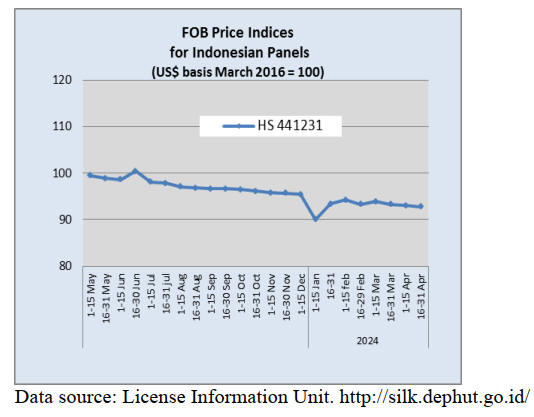
Through the eyes of industry
The latest GTI report lists the challenges identified by the private
sector inIndonesia.
GGSC
https://www.itto-ggsc.org/static/upload/file/20240418/1713424567120852.pdf
5.
MYANMAR
Dire Economic situation
While the Myanmar military regime’s battlefield losses are
grabbing headlines the country’s dire economic crisis is
becoming more apparent. Myanmar has eviscerated over a
decade’s worth of economic growth. Between 2011 and
2019, Myanmar’s economy grew by an average 6% a year
making it one of the fastest growing economies in the
region. Its poverty rate fell from 49% in 2005 to 25% in
2017.
The size of Myanmar's economy remains around 10%
lower than it was in 2019, indicative of the persistent
impacts of recent shocks to both the supply and the
demand side of the economy. Myanmar faces the risk of a
lost generation with erosions in human capital
development.
See:
https://www.rfa.org/english/commentaries/myanmar-economy-abuza-04282024072359.html
Extreme currency depreciation
Information from the foreign exchange market shows that
the Myanmar kyat continues to weaken falling recently to
K3,900 per dollar. The foreign exchange rate on 12 April,
before the New Year Festival was K3,890 for a dollar. The
rate surged to K3,960 on 27 April.
The shortage of dollars has led to currency controls which
have impacting importers and exporters. The kyat lost
16% of its value in the first quarter of 2024 alone while
the price of gold one the local market increased 22%.
In an effort to stablise the domestic currency it has been
reported the Central Bank of Myanmar sold US$15
million and 12 million yuan.
See-
https://www.rfa.org/english/commentaries/myanmar-economy-abuza-04282024072359.html
and
https://www.gnlm.com.mm/myanmar-kyat-depreciates-surpassing-k3900-per-dollar/
Grant from EU but sanctions renewed
As conflict continues in most parts of Myanmar, the
European Commission (EC) has allocated over €19
million in humanitarian aid to address the most urgent
needs. The main EU aid priorities will be food assistance,
emergency shelter and access to healthcare, water and
sanitation as well as protection activities such as mine risk
education.
Out of the total allocation, €2 million is for education.
About a third of school-aged children in the country don't
currently have access to education with many schools
closed or inaccessible due to the conflict.
All EU humanitarian funding is channeled via partner
organisations such as international NGOs and UN
agencies. In Myanmar the EU's partners work with over a
hundred of local civil society organisations to deliver aid
across the country.
Around 18.6 million people, a third of the population, are
estimated to need humanitarian assistance. The UN has
described Myanmar as a global hunger hotspot with a
quarter of the population facing food insecurity.
Health needs are also on the rise as the conflict has
severely disrupted access to healthcare. The increasing
numbers of displaced people often lack shelter as well as
access to water and sanitation.
This €19.2 million initial humanitarian allocation for
Myanmar in 2024 is the highest initial allocation for the
country since the EU began providing humanitarian
assistance. Last year's initial allocation was €17.3 million,
with total financing at the end of the year reaching almost
€33 million.
The European Council has prolonged for one year until 30
April 2025 the restrictive measures in view of the situation
in Myanmar.
The decision was taken on the basis of the annual review
of the restrictive measures and in view of the continuing
grave situation in Myanmar, including actions
undermining democracy as well as serious human rights
violations.
Other EU restrictive measures remain in place: the
embargo on arms and equipment and export restrictions on
equipment for monitoring communications which might
be used for internal repression, the export ban on dual-use
goods for use by the military and border guard police and
the prohibition of military training and cooperation with
the Myanmar Armed Forces (Tatmadaw).
See -
https://ec.europa.eu/commission/presscorner/detail/en/IP_24_568
and
https://www.consilium.europa.eu/nl/press/press-releases/2024/04/26/myanmar-eu-restrictive-measures-renewed-for-a-further-year/pdf/#:~:text=
Thailand urges ASEAN to resolve Myanmar conflict
Thailand urged the regional bloc ASEAN to take a more
proactive role in trying to resolve the crisis in Myanmar.
This came after weeks of fighting near its border that
halted trade and led to a brief influx of refugees.
The Association of Southeast Asian Nations (ASEAN)
developed a peace plan in 2021 that Myanmar's generals
agreed to but it has only been partially implemented
causing frustration in some member countries.
See:
https://www.straitstimes.com/asia/se-asia/thailand-urges-bigger-asean-role-in-resolving-myanmar-conflict
6.
INDIA
Price index for sawnwood
rose in March
The annual rate of inflation based on all India Wholesale
Price Index was 0.53% (Provisional) for March 2024
(compared to over March 2023). The positive rate of
inflation in March 2024 was primarily due to increases in
prices for food, electricity, crude petroleum and natural
gas, machinery and equipment and other manufactured
products.
The index for manufactured products increased by 0.21%
to 140.1 in March 2024, from 139.8 for February 2024.
Out of the 22 NIC two-digit groups for manufactured
products 11 saw an increase in prices, 9 witnessed a
decrease in prices and 2 showed no change in prices.
Some of the important groups that showed month on
month price increases were food products, motor vehicles,
trailers and semi-trailers, rubber and plastics products,
other manufacturing, chemicals and chemical products.
The price index for sawnwood rose sharply in March and
the indices for woodbased panels and veneer continued to
rise.
Some of the groups that witnessed a decrease in prices
were fabricated metal products ( except machinery and
equipment) basic metals; pharmaceuticals, medicinal
chemical and botanical products; textiles; wearing apparel
etc. in March, 2024 as compared to February 2024.
See:
https://eaindustry.nic.in/pdf_files/cmonthly.pdf
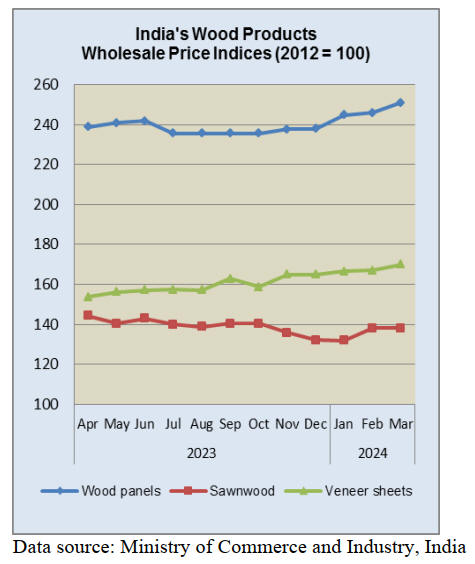
US hardwood exports to India
The American Hardwood Export Council (AHEC) has
reported the value of exports of sawn US hardwood and
veneers to India in 2023 was US$8.482 million. AHEC
has reported that US sawn hardwoods shipped to India
increased by 3% in value to US$7.024 million (up from
US$ 6.839 million in 2022) and by 21% in volume to
11,604 cubic metres (up from 9,614 cubic metres in 2022).
At the same time, direct exports of American hardwood
veneers to India reached US$1.458 million while exports
of logs fell to US$ 3.569 million, down by 47% year on
year.
The top American hardwood species exported to India last
year were white oak, red oak, ash, maple and walnut. The
biggest increases were seen in the value and volume of
exports of ash, maple and walnut.
AHEC participated at INDIAWOOD with an American
hardwood pavilion which included 14 US based hardwood
exporters. AHEC also hosted a ‘mini-convention’ and
trade servicing mission to Jaipur following the conclusion
of INDIAWOOD.
Visits to some of the leading manufacturers helped
American hardwood exporters better understand their
needs. The AHEC convention identified new opportunities
for American hardwoods particularly for the manufacture
of products destined for export markets.
India emerged as the biggest growth market for U.S. sawn
hardwoods in the first half of 2023 and this trend
continued throughout the year.
See:
https://woodzon.com/record-year-for-u-s-hardwood-exports-to-india/
and
https://panelsfurnitureasia.com/ahec-announces-record-year-for-us-hardwood-exports-to-india/#:~:text=The%20total%20value%20of%20exports,Hardwood%20Export%20Council%20(AHEC).
Investment poised to fuel growth
According to a regional economic outlook presented by
the IMF's Asia and Pacific Department, Asia will
contribute around 60% of global economic growth in
2024, an upgrad of its view on the region. Overall, the
region is projected to grow 4.5% this year before slowing
to 4.3% growth in 2024.
In terms of real gross domestic product, India is forecast to
grow 6.8% this year, the fastest pace of any major
economy, while China expands by 4.6%.
Growth in the ASEAN-5, Indonesia, Malaysia, the
Philippines, Singapore and Thailand are forecast to rise
4.5% and Vietnam is projected to achieve gross domestic
product growth closer to 6%.
The shape and drivers of Asia's growth, however, will vary
significantly among countries. Investment looks poised to
fuel much activity in China and India, while private
consumption provides the main engine for other emerging
markets according to the IMF.
See:
https://www.imf.org/en/News/Articles/2024/04/18/tr041824-apd-press-briefing#:~:text=We%20now%20project%20the%20region,Now%2C%20what%20will%20drive%20growth%3F
Spike in forest fires in southern India
Low humidity, above normal daytime temperatures, and
calm winds during this early phase of summer are said to
be some of the contributory factors for the rise in forest
fire incidents reported in the Southern India regions.
The India Meteorological Department recently warned of
an Excess Heat Factor (EHF), a value that predicts the
chances of heatwave over the region, to be significantly
higher than normal over western Andhra Pradesh and
neighboring Karnataka State. Here, the maximum
temperatures in March touched 40 degrees Celsius,
unusual for mid-March.
For nearly a month forest fires have been raging in the
Coonoor forest range and the Indian Air Force
deployed helicopters to drop water on the forest.
Forest fires in this region are unusual as the vegetation is
largely evergreen or semi-evergreen unlike the forests in
northeast Indian states such as Odisha, Maharashtra,
Jharkhand, Chhattisgarh and Uttarakhand where the forst
cover is largely dry deciduous forests.
See:
https://indianexpress.com/article/india/forest-fires-south-india-heat-aridity-clear-skies-9220963/
 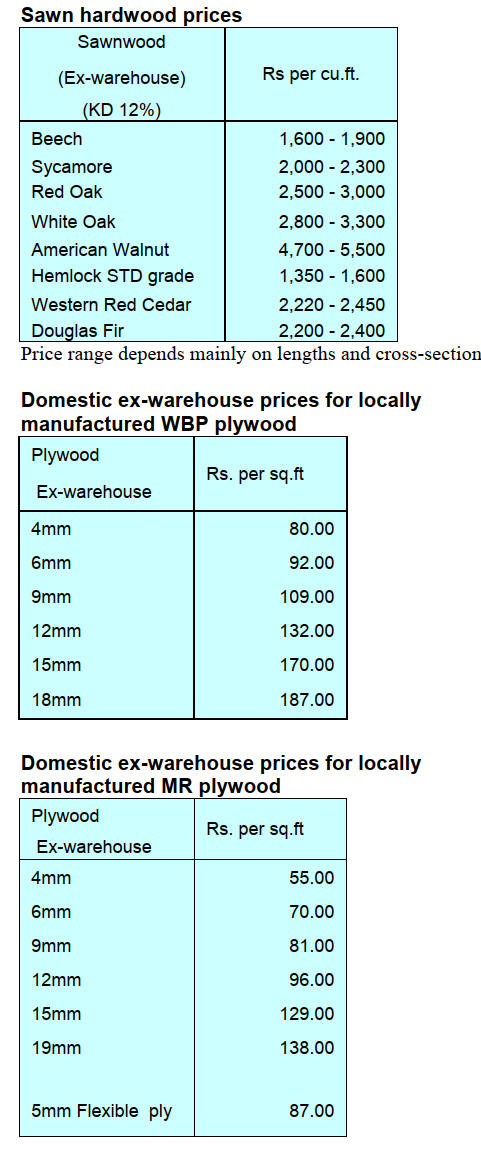
7.
VIETNAM
Wood and wood product (W&WP) trade highlights
According to the Vietnam Office of Customs in March
2024 W&WP exports earned US$1.3 billion, up 69%
compared to February 2024 and up 14% compared to
March 2023. In particular, WP exports contributed
US$887.1 million, up 87% compared to February 2024
and up 14% compared to March 2023.
In the first 3 months of 2024 W&WP exports gained
US$3.5 billion, up 25% over the same period in 2023. WP
exports as a share of the total was US$2.4 billion, up 31%
over the same period in 2023.
Vietnam's W&WP imports in March 2024 stood at
US$193.5 million, up 58.1% compared to February 2024,
but down 0.1% compared to March 2023. Generally, in the
first 3 months of the 2024, W&WP imports recorded at
US$535.7 million, up 15.3% over the same period in 2023.
W&WP exports to the German market in March 2024
reached US$10.1 million, up 37% compared to March
2023. In the first 3 months of 2024 W&WP exports to
Germany were recorded at US$25.8 million, up 33% over
the same period in 2023.
W&WP exports to the UK in March earned US$20.8
million, up 2% compared to March 2023. In the first 3
months of 2024 W&WP exports to UK were valued at
US$53.5 million, up 28% over the same period in 2023.
W&WP exports to Australia in March 2024 amounted to
US$11.6 million, up 8% compared to March 2023. In the
first 3 months of 2024 exports to Australia brought about
US$34.6 million, up 31% over the same period in 2023.
Exports of wooden frame chairs in March 202 amounted
to US$284.1 million, up 17% compared to March 2023. In
the first 3 months of 2024 exports of this wood product
earned US$765.3 million, up 29% over the same period in
2023.
NTFP exports in March 2024 earned US$74.31 million, up
57% compared to February 2024 and up 18% over the
same period in 2023. In the first 3 months of 2024 NTFP
exports were valued at US$201.58 million, up 22% over
the same period in 2023.
Vietnam's pine imports in March 2024 stood at US$56,400
cu.m, worth US$11.1 million, up 17% in volume and 7%
in value compared to February 2024. Compared to March
2023 imports rose 37% in volume and 14% in value.
In the first 3 months of 2024 pine imports totalled 162,700
cu.m, worth US$34.7 million, up 61% in volume and 53%
in value over the same period in 2023.
Vietnam's imports of tali in March 2024 amounted to
14,800 cu.m worth US$6.1 million, up 57% in volume and
58% in value compared to February 2024. Compared to
March 2023 imports were down by 60% in volume and
61% in value.
In the first 3 months of 2024 tali imports totalled at 52,100
cu.m, worth US$20.2 million, down 57% in volume and
59% in value over the same period in 2023.
Log and sawnwood imports from the US market in March
2024 increased and were a record high at 78,000 cu.m
with a value of US$31 million a sharp increase of 164% in
volume and value compared to February 2024 and were up
61% in volume and 44% in value over the same period in
2023.
In the first 3 months of 2024 imports of logs and
sawnwood from the US reached 152,440 cu.m with a
value of US$62.77 million, up 46% in volume and 28% in
value over the same period in 2023.
Export update
According to a report frome VNFOREST under the
Ministry of Agriculture and Rural Development the value
of timber and forest products exports in March was around
US$1.52 billion.
Cumulative exports in the first three months of the year is
estimated at more than US$3.94 billion, an increase of
42% year-on-year of which, exports of wood and wooden
products was almost US$3.7 billion, up 42% and exports
of non-timber forest products reached US$243 million, up
38%.
Major export markets included the US, Japan, China, the
EU and South Korea which together accounted for 90% of
total exports of timber and forest products.
Vietnamese enterprises have been importing wood and
forest products from China, the US, Cameroon, Thailand
and Chile which together account for about 55% of all
imported wood and forest products in the past three
months.
The rise in the value of imports of wood and wood
products increased because of price increases and a steady
rise in demand in the domestic and international markets.
Scheme for multi-use values from forest ecosystems
Earlier this year the Prime Minister of Vietnam
issued Decision 208/QD-TTg approving the project to
develop multi-use values from forest ecosystems - 2030
with a vision to 2050.
This initiative on developing multi-use values from forest
ecosystems involves the following:
Developing legal sources of wood materials
and increase the value of wood products
Form a number of concentrated raw material planted
forests; Prioritise the development of large timber forests
converting from small timber plantations to large timber
plantations in key regions such as the Northeast, North
Central, South Central and Central Highlands; Apply
science and technology to production by selecting,
creating and controlling the quality of seed sources;
Implement intensive technical measures to increase the
productivity and quality of planted forests; Link raw
material production areas with concentrated commodity
processing for a number of products; Build brands to
create a competitive advantages in the international market
and to satisfy domestic market needs.
Gradually increase the proportion of legal raw wood
material supplies from domestic planted forests for the
wood and forest products processing industry.
Planted forests to have a sustainable forest management
certificate or a planting area geolocation code in
accordance with the requirements of the domestic and
international markets.
Develop fine processing and deep processing technology
to increase the added value of wood products; Utilise by-
products in wood processing to produce products for
consumption and export; Gradually form a circular
economy in the forestry production industry; Gradually
reduce the proportion of raw wood products, such as wood
chip production, for export; Encourage the production and
use of wood products from domestically grown forests.
Developing non-timber forest products and
medicinal herbs
Investigate, evaluate and zone for conservation and
development of non-timber forest products and medicinal
plants under the forest canopy; Focus on mastering
information about rare species with high economic value:
distribution area, species, area, reserves; From there,
propose a plan for conservation, exploitation, and
sustainable use according to the potential and strengths of
each product, each ecological region, and promote the
indigenous knowledge of the community and local people.
Research, test, select, create, announce and circulate
varieties and species of non-timber forest products and
medicinal plants with high productivity and quality,
resistance to pests and diseases, and suitability to the
characteristics and natural conditions of each ecological
region.
Develop and complete processes and technical instructions
for seed production, cultivation, and processing of non-
timber forest products and medicinal plants under the
forest canopy, meeting raw material standards for
production associated with stable forest development and
biodiversity conservation in forest ecosystems.
Create production areas for non-timber forest products and
medicinal materials suited to local climate and soil
conditions and suitable for the ecological requirements of
each species. Prioritise tree species that currently extend
over a large area and high economic value on forest land
or under the forest canopy such as: Cinnamon, anise,
lemongrass and yellow camellia growing areas in the
Northeast, North Central and Central Coast provinces.
As well as Vietnamese ginseng growing areas in the
provinces of Quang Nam, Kon Tum, Gia Lai, Lam Dong,
Thua Thien Hue, Nghe An, Lao Cai, Lai Chau, and Dien
Bien; Bamboo and dendrocalamus barbatus growing areas
in the Northwest and North Central provinces; Rattan
growing areas in the North and South Central regions.
Issue planting area geolocation codes for raw material
areas to ensure traceability.
Develop commercial product processing facilities and
factories associated with raw material production areas
along the value chain to meet the standards and
requirements of domestic and international markets;
Ensure product diversification; building brands;
developing handicraft products associated with forest
materials; Developing ‘One Commune One
Product’ (OCOP) medicinal products and develop
products suitable to the characteristics of the national
cultural identity of ethnic minorities.
Developing combined forms of agriculture,
forestry and fishery
Summarise, evaluate and combine economic development
models for agriculture, forestry and fisheries such as:
forest garden and forest camp models; Cltivating and
developing medicinal plants, multi-purpose plants,
livestock, and aquaculture under a forest canopy; Share
experiences, knowledge, document, develop processes,
standards, regulations and technical instructions to
disseminate and replicate successful and effective models.
Select high-value, multi-purpose crop and livestock
species suitable to local conditions and market needs.
Apply effective farming methods and manage the quality
of crops, livestock, aquatic products, etc. combined under
the forest canopy to optimise land use efficiency;
Production and trade of agricultural, forestry and fishery
products do not cause deforestation and affect the natural
environment and biodiversity of forest ecosystems.
Organise sustainable and effective cooperation and
production links between businesses, organisations,
households, individuals and communities; Promote
responsibility and encourage participation in forest
management and community benefit sharing and ensure
harmony in the legitimate rights and interests of
participating parties.
Developing forest environmental services
Develop forest environmental services, diversify and
expand revenue sources from various types of forest
environmental services in accordance with the law,
especially forest carbon absorption and storage services;
Reduce greenhouse gas emissions by limiting
deforestation and forest degradation, implementing
sustainable forest management and promoting green
growth.
Research and institutionalise regulations on applying rates
for forest environmental services that are close to the real
value that forests bring, in accordance with economic
development practices, gradually increase income, and
stabilise the lives of people directly involved in forest
management, protection, and development.
Strengthen management and guidance to improve the
efficiency of using revenue from forest environmental
services to invest in the protection and sustainable
development of forest resources; Ensure equitable sharing
of benefits with local communities.
Developing eco-tourism, resorts and
entertainment
Guide forest owners to develop and implement eco-
tourism, resort and entertainment projects; Assess impacts
and take strict control measures and minimise negative
impacts of eco-tourism, resort and entertainment activities
for forest management, nature conservation, biodiversity
of forest ecosystem, and socio-economic development.
Research promoting and supporting forest owners to self-
organise ecotourism, resort, and entertainment activities
according to regulations.
Strengthen cooperation between forest owners and local
communities; Encourage communities to participate in the
process of planning, managing and providing tourism
products and services; Preserve and promote indigenous
knowledge and cultural traditions and ensure equitable
sharing of benefits with local communities.
Develop eco-tourism models associated with agricultural,
rural and community-based tourism for ethnic minorities,
mountainous people, and people living in and near forests.
Develop unique and unique tourism types and products
associated with the natural landscape value of the forest
ecosystem demonstrating regional and inter-regional
connectivity and creating products, activities, and tourism
brands associated with local traditional culture and
geographical region.
Develop promotion and marketing strategies and media
channels to introduce and provide feedback on ecotourism
and rural tourism activities; Use social networks and
websites and organize events (seminars, conferences, fairs,
photo exhibitions, etc.) to bring information to domestic
and international tourists.
Attract resources to participate in sustainable development
of eco-tourism, relaxation and entertainment in forest
ecosystems; Support job creation and improve livelihoods
through the use of local labour. Guides organisations and
individuals organising tourism activities in adjacent areas
and regions or areas bordering organisations organising
eco-tourism, resorts and entertainment areas in forest
ecosystems.
See:
https://lawnet.vn/thong-tin-phap-luat/en/chinh-sach-moi/approval-of-the-scheme-for-developing-multi-use-values-of-forest-ecosystems-in-vietnam-till-2030-with-a-vision-to-2050-133552.html
and
https://vietnamnews.vn/environment/1651223/project-to-develop-multi-use-values-of-forest-ecosystem-to-2030-approved.html
8. BRAZIL
Forestry sector ups job
creation
A survey carried out by the Center for Timber Producing
and Exporting Industries of Mato Grosso State (CIPEM)
shows that formal jobs in the state's forestry sector grew in
the first two months of 2024.
Currently, the forestry sector employs 12,712 people,
equivalent to 9.8% of the total 128,917 workers employed
in the State's manufacturing industry according to the
Ministry of Labour and Employment.
CIPEM commented that in the coming months the trend is
for the forest-based sector to continue creating jobs as
timber industries have been expanding production from
sustainable forest management areas.
With the aim of expanding trade CIPEM promotes and
participates in national and international events that
discuss the contribution of the forest-based sector to
sustainable socio-economic development.
CIPEM emphasised that approximately 7 million cubic
metres of timber are produced annually from Sustainable
Forest Management areas demonstrating that forest-based
industries have the potential to provide sustainable
products with proof of origin, traceability and quality.
See:
https://cipem.org.br/noticias/setor-florestal-dobra-a-geracao-de-empregos-em-2024
Strategies for forest restoration in the Amazon
Environmental leaders from the Legal Amazon gathered in
Rio Branco, the capital of the State of Acre in the Amazon
Region, to discuss strategies for forest restoration and
sustainable development during the 27th Regional
Governors' Forum.
The event, led by Acre's Environment Secretariat, focused
on international cooperation for the development and
conservation of the Amazon, the implementation of
policies and economic incentives for forest restoration and
strategies in the private sector for preserving the Amazon.
The importance of collaboration between different sectors
and countries was emphasised.
The event aimed to create an "ecosystem of innovation and
forest restoration" that adds perspectives to a common
goal of conservation of the Amazon's natural resources.
Discussions, organised in various panels, served as a
platform for in-depth discussions on international
cooperation, forest restoration policies, how REDD+
programmes can benefit the region and plans for
recovering native vegetation along with the role of the
private sector and implementing agencies in
environmental management.
Ambitious goals were presented, such as the "Restore the
Amazon" project, which aims to restore 24 million
hectares in the region by 2050 through significant
investment and a focus on job creation and biodiversity
conservation.
The first phase of the project, until 2030, involves the
restoration of 6 million hectares with an initial investment
of R$51 billion (approximately US$10 billion). The
second phase, which runs until 2050, aims to restore an
additional 18 million hectares at a cost of R$153 billion
(around US$30 billion).
The Amazon Fund and the Climate Fund will play crucial
roles in financing these initiatives with an initial allocation
of R$450 million by the Amazon Fund and R$550 million
from the Climate Fund planned for 2024.
It is estimated that 14,000 jobs will be created and 165
billion tonnes of carbon will be removed from the
atmosphere significantly contributing to global emissions
reduction targets. To conclude the Forum the signing of a
technical cooperation agreement between the Acre State
Environment Secretariat and Embrapa Acre was
announced.
This agreement is part of a detailed work plan to advance
the application of geo-technologies in monitoring forest
recovery in the state of Acre.
See:
https://oriobranco.net/secretarios-de-meio-ambiente-da-amazonia-legal-debate-estrategias-para-restauracao-florestal/
Export update
In March 2024 Brazilian exports of wood-based products
(except pulp and paper) declined 16% in value compared
to March 2023, from US$341.0 million to US$287.7
million.
Pine sawnwood exports dropped 28% in value between
March 2023 (US$60.1 million) and March 2024 (US$43.6
million). In volume, exports decreased 27% over the same
period, from 258,900 cu.m to 188,500 cu.m.
Tropical sawnwood exports decreased 39% in volume
from 27,000 cu.m in March 2023 to 16,500 cu.m in March
2024. In value, exports decreased 48% from US$14.6
million to US$7.6 million over the same period.
Pine plywood exports increased 1% in value in March
2024 (US$68.6 million) compared to March 2023 (US$
67.8 million). In volume, exports decreased 2% over the
same period, from 213,500 cu.m (March 2023) to 208,800
cu.m. (March 2024)
As for tropical plywood, exports dropped 44% in volume
44% and by 33% in value, from 3,400 cu.m and US$1.8
million in March 2023 to 1,900 cu.m and US$1.2 million
in March 2024 respectively.
The wooden furniture export value decreased from
US$54.4 million in March 2023 to US$45.4 million in
March 2024, a 17% drop.
Opportunity for the Brazilian furniture industry
According to a recent study the economic situation in the
United Kingdon (UK) offers opportunities for Brazilian
furniture exports. With its economy ranked as the fifth
largest in the world, UK is a target market for Brazil.
According to the indicators from the "Study of
Opportunities for the Brazilian Furniture and Mattress
Exporters - Target Country: United Kingdom" developed
by IEMI, the UK stands out for its robust furniture
industry which significantly contributes to the economy,
employing around 339,000 people and representing 2% of
the country's industrial GDP in 2022.
The demand for furniture, particularly office and
institutional furniture, representing 30% of production,
illustrates the importance of this sector.
One of the largest furniture consumer markets in Europe,
the UK imported US$8.7 billion in 2022 and exported
around US$1.5 billion.
With a trade deficit of US$7.2 billion and a considerable
dependence on imported products which accounted for
59% of the apparent furniture consumption indicating
considerable trade openness. Brazil is ranked 23rd among
furniture exporting countries to the UK illustrating the
potential for growth.
Factors such as price and the environmental ethics of
brands decisively influence purchasing behavior in the UK
with 59% of consumers considering price to be crucial and
around 50% willing to pay more for products from ethical
brands.
According to IEMI a strategy to increase market share in
the UK would involve, not only products diversification
but also entering the higher value-added segments taking
advantage of the British tendency towards ethical and
sustainable brands. IEMI forecasts that the Brazilian
furniture industry can count on a growth of exports to the
UK reaching up to US$85.6 million over the next few
years.
Another essential strategy for the Brazilian industry to
access and advance in the UK market is the participation
in international furniture events such as Salone del
Mobile.Milano, the largest international furniture fair
which attracts players from all over the EU and various
parts of the world.
See:
https://www.brazilianfurniture.org.br/noticias/detalhe/oportunidades-para-a-industria-brasileira-de-moveis-no-mercado-global-mais-da-metade-do-consumo-de-moveis-no-reino-unido-e-suprido-por-importacoes
Mato Grosso expands international trade in wood
products
The timber industries in the forest sector in the State of
Mato Grosso, one of the main tropical timber producing
states, generated approximately US$104.6 million in
revenue in 2023. The State traded with around 61
countries with significant trade with the United States
(US$16.7 million), India (US$13 million) and China
(US$11 million).
According to the Ministry of Development, Industry and
Foreign Trade (MDIC) among the main items traded were
roundwood (mainly teak), sawnwood and profiled timber.
The Ministry of Agriculture, Livestock and Food Supply
(MAPA) also points out that in the first quarter of 2024 the
State of Mato Grosso was the fourth largest exporter of
Brazilian timber at approximately US$18.3 million.
CIPEM pointed out that Mato Grosso State has
approximately 5.0 million hectares of managed and
conserved forests and that the sector is extremely
important for the State economy in various municipalities
through job creation and has a robust traceability system
(Sisflora 2.0) ensuring the origin and legality of Mato
Grosso products.
To expand timber exports the sector is seeking to address
issues hindering the trade of wood products from natural
forests such as the delay of up to four months in clearance
of goods at Brazilian ports.
The National Forum of Forest-Based Activities (FNBF)
emphasises that one of viable alternatives for speeding up
exports is the Dry Port in Cuiabá which could also serve
the northern states. A second alternative would be to
expand the staff at the ports to address obstacles and speed
up international shipments.
CIPEM also highlights the solution implemented in 2024
to reduce bureaucracy, expand and strengthen the trade in
timber obtained from Sustainable Forest Management
Plans in the state through the launch of ABNT PR 1020
Recommended Practice - Management in native tropical
forest, a standard that values forest management thus
ensuring more security for consumers.
See:
https://cipem.org.br/noticias/setor-florestal-de-mato-grosso-fatura-us-1046-milhoes-em-negocios-com-61-paises
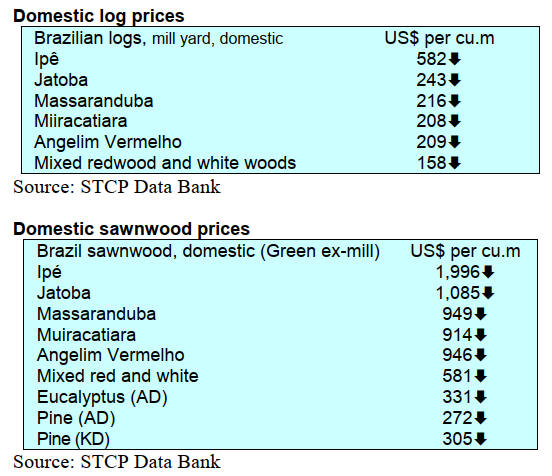
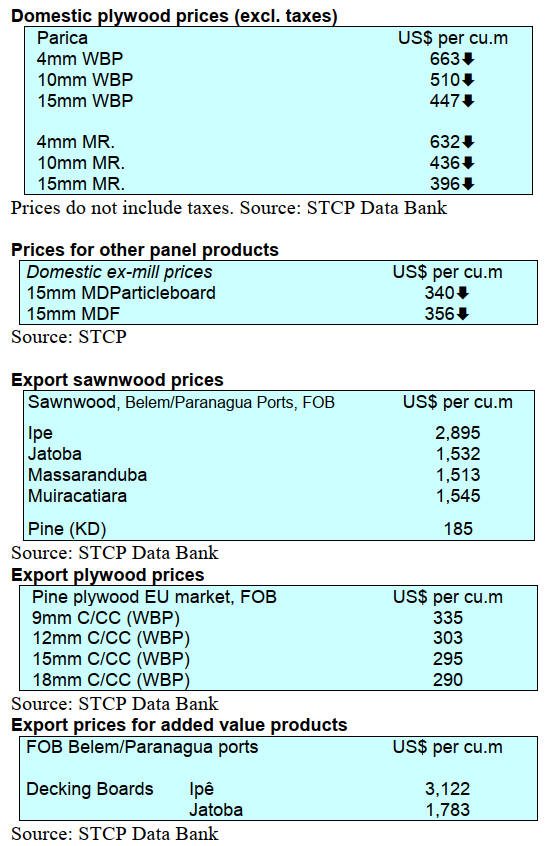
Through the eyes of industry
The latest GTI report lists the challenges identified by the private
sector in Brazi.
GGSC
https://www.itto-ggsc.org/static/upload/file/20240418/1713424567120852.pdf
9. PERU
Exports to main buyers
fell in first two months of 2024
Export shipments of wood products for January and
February were worth US$2.4 million, a year on year
decline of 26% according to the Services Management and
Extractive Industries Division of the Association of
Exporters (ADEX).
This decline is partly explained by lower orders from the
two main buyers, China (US$2.1 million) and France
(US$1.9 million) which reflect decreased demand of 30%
and 48% respectively. Regarding China, the global real
estate sector continues to face a severe crisis and this is
affcecting imports.
Other export markets were the Dominican Republic
(US$1.5 million, 12% of all exports), the United States
(US$1.4 million, 11% and Mexico (US$1.2 million a share
of 10%.
According to figures from the ADEX Data Trade
Commercial Intelligence System, sawn wood was the most
traded product in the first two months of the year despite
having contracted by 16% year on year. Second in the
ranking of exports were semi-manufactured products
down 44%. Others were furniture products and their parts,
firewood and charcoal and manufactured products.
Incentives for forest plantations
The National Forestry and Wildlife Service (SERFOR)
through its Sustainable Productive Forests (BPS)
programme together with the Regional Government of San
Martín announced the start of the Forest Incentives
Program (PIF) which will allow native communities,
farmers and producers to access to financing up to
US$200,000 to establish forest plantations.
The PIF was announced at the International Forestry
Forum ‘Favorable environment for innovative and
sustainable forestry businesses in Peru’ held 25-26 April.
The Executive Director of SERFOR, Luis Alberto
Gonzales-Zúñiga, has been quoted as saying “we are going
to provide incentives to associations, producers and native
communities so that they can invest in the development of
forest plantations.
There is a fund of US$24 million available over a period
of five years in seven Departments of the country;
Cajamarca, Áncash, Madre de Dios, Pasco, Huánuco, San
Martín and Junín”.
See:
https://www.gob.pe/institucion/serfor/noticias/945028-peru-lanza-programa-de-incentivos-de-hasta-s-742-mil-para-productores-de-plantaciones-forestales
Mechanism to compensate for fines for
forest offenses
In an effort to provide effective solutions for forest users
facing fines for violations of forest regulations the Forest
and Wildlife Resources Supervision Agency (OSINFOR)
explained to participants at a meeting in Ucayali how the
fine compensation mechanisms will work.
With the participation of 20 attendees, including holders,
representatives of enabling titles for private properties and
timber forestry concessions as well as representatives of
institutions related to the forestry sector, the event on 16
April in Pucallpa addressed the mechanisms available to
offset fines for violations of forestry and wildlife
legislation.
Fine compensation mechanisms are a non-monetary
payment alternative, an aspect that generated great interest
and commitment among those present. Many were
unaware of the possibility of using other resources to
compensate for their fines.
During the day the requirements to access the
compensation mechanisms, the responsibilities that the
holders acquire when availing themselves of the various
mechanisms as well as the causes of loss of this benefit,
were highlighted.
Among the mechanisms that were emphasised were
participation in training actions, compensation for
recognition of activities of the Community Forest
Surveillance and Control Committee (CVCFC) and
compensation for other supervised actions.
See:
https://www.gob.pe/institucion/osinfor/noticias/944919-usuarios-del-bosque-en-ucayali-conocen-los-mecanismos-para-compensar-multas-por-infracciones-forestales


|